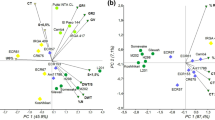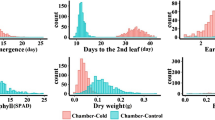Abstract
Given the importance of early cold tolerance in maize (Zea mays L.), we previously conducted a divergent selection for low (L) and high (H) cold tolerance at germination. The source population was the F2 of B73 × IABO78 single cross. Selection was first conducted as recurrent selection (four cycles) and then in inbreeding (three generations). Ten lines were finally selected for L and ten for H; these lines were then evaluated to investigate: (i) their field cold tolerance in the early autotrophic phase and the relationship with the cold tolerance expressed at emergence and in the heterotrophic phase; (ii) the inheritance of these cold tolerance traits; (iii) their agronomic performance as lines per se and as crosses; (iv) their SNP-based genetic characterization. For all cold tolerance traits, the H group of lines was superior to the L group; selection responses were often symmetric, suggesting the prevalence of additive effects. The relationship among cold tolerance traits was appreciable, suggesting a common genetic basis. Differences among testcrosses were largely due to general combining ability effects and the relationship between line per se and testcross performance was high, confirming the prevalence of additive effects. Correlated responses were also obtained for agronomic traits, the H lines being superior to L lines both per se and as crosses. For SNP-marker loci, the B73 allelic frequency was greater in the H group (61.7 %) than in L group (39.7 %). Across field trials, an H line excelled for all traits, thus proving to deserve further investigations.

Similar content being viewed by others
References
Aidun VL, Migus WN, Hamilton RI (1991) Use of inbred seedling cold tolerance to predict hybrid cold tolerance in maize (Zea mays L.). Can J Plant Sci 71:663–667
Beissinger TM, Hirsch CN, Vaillancourt B, Deshpande S, Barry K, Buell CR, Kaeppler SM, Gianola D, De Leon N (2014) A genome-wide scan for evidence of selection in a maize population under long-term artificial selection for ear number. Genetics 196:829–840
Bhosale SU, Rymen B, Beemster GTS, Melchinger AE, Reif JC (2007) Chilling tolerance of central European maize lines and their factorial crosses. Ann Bot 100:1315–1321
Crosbie TM, Mock JJ, Smith OS (1980) Comparison of gains predicted by several selection methods for cold tolerance traits in two maize populations. Crop Sci 20:649–655
Efron B, Tibshirani RJ (1993) An Introduction to the Bootstrap. Chapman and Hall, London, p 214
Excoffier L, Smouse P, Quattro J (1992) Analysis of molecular variance inferred from metric distances among DNA haplotypes: application to human mitochondrial DNA restriction data. Genetics 131:479–491
Falconer DS, Mckay TFC (1996) Introduction to quantitative genetics, 4th edn. Longman, London
Fracheboud Y, Jompuk C, Ribaut JM, Stamp P, Leipner J (2004) Genetic analysis of cold-tolerance of photosynthesis in maize. Plant Mol Biol 56:241–253
Frascaroli E, Landi P (2013) Divergent selection in a maize population for germination at low temperature in controlled environment: study of the direct response, of the trait inheritance and of correlated responses in the field. Theor Appl Genet 126:733–746
Gallais A, Moreau L, Charcosset A (2009) Detection of marker–QTL associations by studying change in marker frequencies with selection. Theor Appl Genet 114:669–681
Ganal MW, Durstewitz G, Polley A, Berard A, Buckler ES, Charcosset A, Clarke JD, Graner EM, Hansen M, Joets J, Le Paslier MC, McMullen MD, Montalent P, Rose M, Schön CC, Sun Q, Walter H, Martin OC, Falque M (2011) A large maize (Zea mays L.) SNP genotyping array: development and germplasm genotyping, and genetic mapping to compare with the B73 reference genome. PLoS ONE 6(e28):334
Gardner CO, Thomas-Compton MA, Goken TL, Eichelberger KD (1987) selection for cold and freeze tolerance in corn: evaluations of original and selected populations. Ann Corn Sorghum Res Conf 42:126–140
Gower JC (1966) Some distance properties of latent root and vector methods used in multivariate analysis. Biometrika 53:325–338
Greaves JA (1996) Improving suboptimal temperature tolerance in maize-the search for variation. J Exp Bot 47(296):307–323
Hallauer AR, Miranda Fo JB (1988) Quantitative genetics in maize breeding. Iowa State University Press, Ames
Hirsch CN, Flint-Garcia SA, Beissinger TM, Eichten SR, Deshpande S, Barry K, McMullen MD, Holland JB, Buckler ES, Springer N, Buell CR, De Leon N, Kaeppler SM (2014) Insights into effects of long-term artificial selection on seed size in maize. Genetics 198:409–421
Hoard KG, Crosbie TM (1986) Correlated changes in agronomic traits from S1-line recurrent selection for cold tolerance in two maize populations. Crop Sci 26:519–522
Hodges DM, Andrews CJ, Johnson DA, Hamilton RI (1997) Sensitivity of maize hybrids to chilling and their combining abilities at two developmental stages. Crop Sci 37:850–856
Jompuk C, Fracheboud Y, Stamp P, Leipner J (2005) Mapping of quantitative trait loci associated with chilling tolerance in maize (Zea mays L.) seedlings grown under field conditions. J Exp Bot 56:1153–1163
Lamkey KR, Hallauer AR (1986) Performance of High × High, High × Low, and Low × Low crosses of lines from the BSSS maize synthetic. Crop Sci 26:1114–1118
Landi P, Frascaroli E, Lovato A (1992) Divergent full-sib recurrent selection for germination at low temperature in a maize population. Euphytica 64:21–29
Lebowitz RL, Soller M, Beckmann JS (1987) Trait-based analysis for the detection of linkage between marker loci and quantitative trait loci in cross between inbred lines. Theor Appl Genet 73:556–562
Leipner J, Jompuk C, Camp K, Stamp P, Fracheboud Y (2008) QTL studies reveal little relevance of chilling stress-related seedling traits for yield in maize. Theor Appl Genet 116:555–562
Maryam B, Jones D (1983) The genetics of maize (Zea mays L.) growing at low temperatures. I. Germination of inbred lines and their F1s. Euphytica 32:535–542
McConnell RL, Gardner CO (1979a) Selection for cold germination in two corn populations. Crop Sci 19:765–768
McConnell RL, Gardner CO (1979b) Inheritance of several cold tolerance traits in corn. Crop Sci 19:847–852
Menkir A, Larter EN (1985) Growth responses of early maturing inbred lines of corn to suboptimal temperatures. Can J Plant Sci 65:79–86
Mock JJ, Bakri AA (1976) Recurrent selection for cold tolerance in maize. Crop Sci 16:230–233
Mock JJ, Eberhart SA (1972) Cold tolerance in adapted maize populations. Crop Sci 12:466–469
Mock JJ, McNeill MJ (1979) Cold tolerance of maize inbred lines adapted to various latitude in North America. Crop Sci 19:239–242
Montes JM, Technow F, Dhillon BS, Mauch F, Melchinger AE (2011) High-throughput non-destructive biomass determination during early plant development in maize under field conditions. Field Crops Res 121:268–273
Navabi A, Mather DE, Bernier J, Spaner DM, Atlin GN (2009) QTL detection with bidirectional and unidirectional selective genotyping: marker-based and trait-based analyses. Theor Appl Genet 118:347–358
Nguyen HT, Leipner J, Stamp P, Guerra-Peraza O (2009) Low temperature stress in maize (Zea mays L.) induces genes involved in photosynthesis and signal transduction as studied by suppression subtractive hybridization. Plant Physiol and Biochem 47:116–122
Paradis E (2010) Pegas: an R package for population genetics with an integrated-modular approach. Bioinformatics 26:419–420
Paradis E, Claude J, Strimmer K (2004) APE: analyses of phylogenetics and evolution in R language. Bioinformatics 20:289–290
Presterl T, Ouzunova M, Schmidt W, Möller EM, Röber FK, Knaak C, Ernst K, Westhoff P, Geiger HH (2007) Quantitative trait loci for early plant vigour of maize grown in chilly environments. Theor Appl Genet 114:1059–1070
R Development Core Team (2011) R: A Language and Environment for Statistical Computing. R Foundation for Statistical Computing, Vienna, Austria. http://www.R-project.org/, ISBN 3-900051-07-0
Revilla PA, Butrón A, Malvar RA, Ordás A (1999) Relationships among kernel weight, early vigor, and growth in maize. Crop Sci 39:654–658
Revilla P, Malvar RA, Cartea ME, Butrón A, Ordás A (2000) Inheritance of cold tolerance at emergence and during early season growth in maize. Crop Sci 40:1579–1585
Revilla P, Rodríguez VM, Ordás A, Rincent R, Charcosset A, Giauffret C, Melchinger AE, Schön CC, Bauer E, Altman T, Brunel D, Moreno-González J, Campo L, Ouzunova M, Laborde J, Álvarez Á, Ruíz de Galarreta JI, Malvar RA (2014) Cold tolerance in two large maize inbred panels adapted to European climates. Crop Sci 54:1981–1991
Ritchie SW, Hanway JJ, Benson GO (1993) How a corn plant develops. Spec Rpt 48 Coop Ext Serv Iowa State University, Ames, IA
Rodríguez VM, Butrón A, Sandoya G, Ordás A, Revilla P (2007) Combining maize base germplasm for cold tolerance breeding. Crop Sci 47:1467–1474
SAS Institute (2011) The SAS system for Windows. Release 9.2. SAS Institute, Cary
Sen S, Johannes F, Broman KW (2009) Selective genotyping and phenotyping strategies in a complex trait context. Genetics 181:1613–1626
Sezegen B, Carena MJ (2009) Divergent recurrent selection for cold tolerance in two improved maize populations. Euphytica 167:237–244
Shinozaki K, Yamaguchi-Shinozaki K, Seki M (2003) Regulatory network of gene expression in the drought and cold stress responses. Curr Opin Plant Biol 6:410–417
Steel RGD, Torrie JH, Dickey DA (1997) Principles and procedures of statistics: a biometrical approach, 3rd edn. McGraw Hill Inc, New York
Strigens A, Grieder C, Haussmann BIG, Melchinger AE (2012) Genetic variation among inbred lines and testcrosses of maize for early growth parameters and their relationship to final dry matter yield. Crop Sci 52:1084–1092
TeKrony DM, Egli DB, Wickham DA (1989) Corn seed vigor effect on no-tillage field performance. I. Field emergence. Crop Sci 29:1523–1528
Verheul MJ, Picatto C, Stamp P (1996) Growth and development of maize (Zea mays L.) seedlings under chilling conditions in the field. Eur J Agron 5:31–43
Weir BS (1996) Genetic data analysis II. Sinauer Associates Inc, Sunderland
Wright S (1978) Evolution and the Genetics of Populations, vol 4., Variability within and among natural populations. University of Chicago Press, Chicago
Zaidi PH, Yadav M, Maniselvan P, Khan R, Shadakshari TV, Singh RP, Pal D (2010) Morpho-physiological traits associated with cold stress tolerance in tropical maize (Zea mays L.). Maydica 55:201–208
Acknowledgments
The authors are grateful to Drs. P. Revilla, J. Leipner and A.E. Melchinger for having provided seeds of the inbred lines EA2087, EP42, ETH-DH7 and D23. We also acknowledge Dr. S. Corneti who carried out the DNA extraction of the investigated lines and all the graduate and undergraduate students who helped us in the accomplishment of the study herein presented. We finally acknowledge two anonymous reviewers for valuable suggestions.
Funding
This study was conducted with the financial support of the University of Bologna, Grant RFO (2009–2014).
Author information
Authors and Affiliations
Corresponding author
Ethics declarations
Conflict of interest
The authors declare that they have no conflict of interest.
Electronic supplementary material
Below is the link to the electronic supplementary material.
Rights and permissions
About this article
Cite this article
Frascaroli, E., Landi, P. Cold tolerance in field conditions, its inheritance, agronomic performance and genetic structure of maize lines divergently selected for germination at low temperature. Euphytica 209, 771–788 (2016). https://doi.org/10.1007/s10681-016-1680-8
Received:
Accepted:
Published:
Issue Date:
DOI: https://doi.org/10.1007/s10681-016-1680-8




